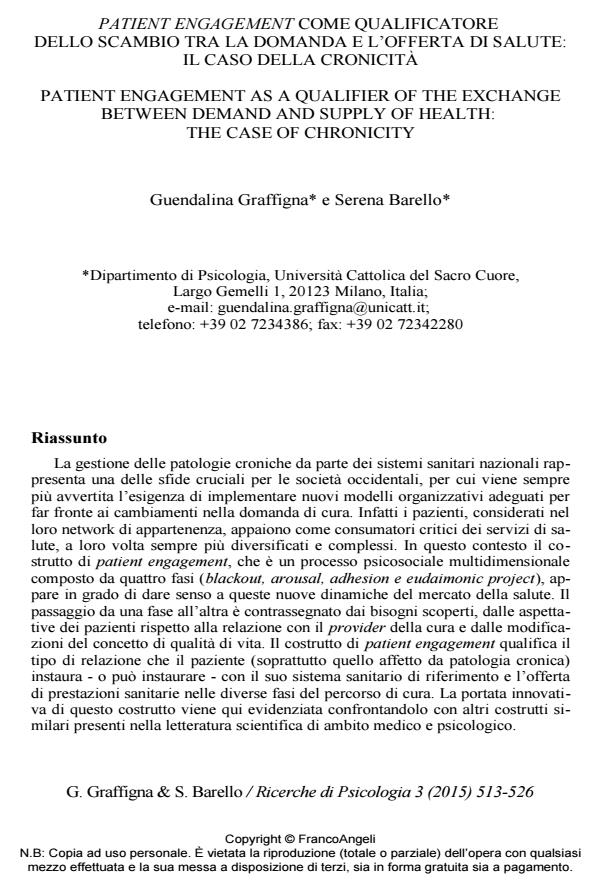Patient engagement come qualificatore dello scambio tra la domanda e l’offerta di salute: il caso della cronicità
Titolo Rivista RICERCHE DI PSICOLOGIA
Autori/Curatori Guendalina Graffigna, Serena Barello
Anno di pubblicazione 2015 Fascicolo 2015/3
Lingua Italiano Numero pagine 14 P. 513-526 Dimensione file 211 KB
DOI 10.3280/RIP2015-003005
Il DOI è il codice a barre della proprietà intellettuale: per saperne di più
clicca qui
Qui sotto puoi vedere in anteprima la prima pagina di questo articolo.
Se questo articolo ti interessa, lo puoi acquistare (e scaricare in formato pdf) seguendo le facili indicazioni per acquistare il download credit. Acquista Download Credits per scaricare questo Articolo in formato PDF

FrancoAngeli è membro della Publishers International Linking Association, Inc (PILA)associazione indipendente e non profit per facilitare (attraverso i servizi tecnologici implementati da CrossRef.org) l’accesso degli studiosi ai contenuti digitali nelle pubblicazioni professionali e scientifiche
La gestione delle patologie croniche da parte dei sistemi sanitari nazionali rappresenta una delle sfide cruciali per le società occidentali, per cui viene sempre più avvertita l’esigenza di implementare nuovi modelli organizzativi adeguati per far fronte ai cambiamenti nella domanda di cura. Infatti i pazienti, considerati nel loro network di appartenenza, appaiono come consumatori critici dei servizi di salute, a loro volta sempre più diversificati e complessi. In questo contesto il costrutto di patient engagement, che è un processo psicosociale multidimensionale composto da quattro fasi (blackout, arousal, adhesion e eudaimonic project), appare in grado di dare senso a queste nuove dinamiche del mercato della salute. Il passaggio da una fase all’altra è contrassegnato dai bisogni scoperti, dalle aspettative dei pazienti rispetto alla relazione con il provider della cura e dalle modificazioni del concetto di qualità di vita. Il costrutto di patient engagement qualifica il tipo di relazione che il paziente (soprattutto quello affetto da patologia cronica) instaura - o può instaurare - con il suo sistema sanitario di riferimento e l’offerta di prestazioni sanitarie nelle diverse fasi del percorso di cura. La portata innovativa di questo costrutto viene qui evidenziata confrontandolo con altri costrutti similari presenti nella letteratura scientifica di ambito medico e psicologico.
Parole chiave:Patient engagement, cronicità, comunicazione, marketing della salute, relazione medico-paziente, qualità della vita.
Guendalina Graffigna, Serena Barello, Patient engagement come qualificatore dello scambio tra la domanda e l’offerta di salute: il caso della cronicità in "RICERCHE DI PSICOLOGIA " 3/2015, pp 513-526, DOI: 10.3280/RIP2015-003005